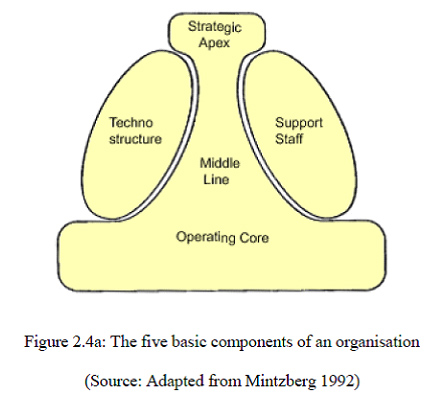Mintzberg and Quinn’s Model of Change
Mintzberg and Quin (1991) proposed 4 broad situational factors which can influence the extent to which an organization can change. These factors are organizational age and size, the technical systems of the organization, organizational environment and the nature of control exerted from various sources.
- Organizational Age and Size: This is one of the most important factors as according to Mintzberg and Quinn, formalized behaviour are practised in much older organizations, while larger organizations have more elaborate structures and larger structures reflect the age of the industry since it got established.
Young organizations which are relatively in the start-up stage, have relatively smaller structures and hence they spend less time on establishing formal traditions and practices which in due course of time may act as barriers to change. Hence the young organizations adjust with the change and accept the change.
But on the other hand, the older organizations which have formal structures and strongly established traditions and practices find it difficult to adjust to the changes and are less flexible in their approach. Large organizations follow greater hierarchy required for supervising the employee activities and need to maintain greater control.
- Technical System: Technical System constitutes the instruments used by the organization for producing the desired outputs. The Technical System can affect the organizational structure broadly in 3 different ways:
- Organizations which are highly regulated and dominated by the technical systems display more of bureaucratic structures.
- Organizations having highly complex technical systems, tend to delegate the process of decision making to highly skilled or professional staff for managing the technical staff.
- Organizations with automated technical systems tend to adopt much fluid and flexible structure, for proactively responding to the changing requirements of the times.
- Environment: The environmental factors are the external factors which are beyond the organizational control, market driven forces, socio-political environment, economic changes and many others. The environmental factors influence the organizations in the following ways in terms of their adaptability with the change:
- Organizations which operate in dynamic environments tend to follow more organic structures
- Organizations which exist in complex environments adopt more decentralized structures.
- Organizations existing in diversified market conditions adopt market driven divisional structures
- Organizations operating in hostile environments adopt a more centralized form of structures.
- Nature of Control/Power: The following considerations determine the extent to which power can influence change in an organization:
- More centralized and formalized structure is adopted by the organizations having greater external control.
The model further goes on to describing 5 main components of an organization which influence the extent to which an organization need to change. These components are:

- Operating Core: This constitutes the employees who perform the basic activities related to the process of production of various products and services.
- Strategic Apex: This constitutes those group of people who are responsible for implementing strategic decisions for realizing the organizational mission and objectives. They enjoy power and control.
- Middle Line Managers: The Middle Line Managers act as the intermediary and the link between the operating core and the strategic apex.
- Techno structure: The analysts (employees) are hold the responsibility of planning and executing the change, implementing vital decisions related with the change and responsible for training other employees for implementing the change.
- Support Staff: The Support Staff are primarily the specialized units.
According to Mintzberg, all the components need to blend for improved organizational functioning. He equally maintained that organizational structures can be identified as machine organization (bureaucracy), entrepreneurial organization, the innovative organization (adhocracy) and the divisional (diversified) organization.
He explained that machine organizations have more formalized structures and rely on standardized processes, routines and procedures are involved in the process of organizational functioning, is based on centralized decision-making process, and moreover, tasks are clustered or grouped in accordance with the functional departments.
He further described that machine organizations have a vertical structure, in which the decision making is centralized and the senior management implement decisions centrally. Since the machine organizations follow centralized decision making and are formalized structures like the government organizations, hence they can do well when it comes to handling the routine nature of works but not under circumstances when radical decisions are supposed to be implemented.
Limitations of this Model
- The model skips the analysis of the relationship which exists between organizational effectiveness and the managerial behaviour.
- Their assumptions were based on the analysis of the patterns of change and structures of small samples of organizations, which cannot be generalized to the entire industry or all the organizations.
- The model presumes the neutrality of the managerial role ignoring a lot of other vital factors.
- The model does not take into consideration the factors before introducing the change like the roles of an effective or a successful change initiator.
| ❮❮ Previous | Next ❯❯ |
 Related Articles
Related Articles
- Pre-Requisites for Successful Change Management
- Overcoming Barriers to Change
- Senior Managers as Barriers to Change
Authorship/Referencing - About the Author(s)
The article is Written and Reviewed by Management Study Guide Content Team. MSG Content Team comprises experienced Faculty Member, Professionals and Subject Matter Experts. We are a ISO 2001:2015 Certified Education Provider. To Know more, click on About Us. The use of this material is free for learning and education purpose. Please reference authorship of content used, including link(s) to ManagementStudyGuide.com and the content page url.